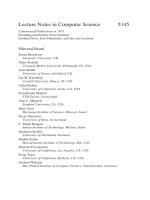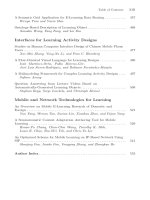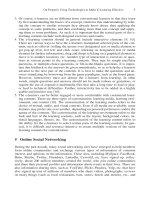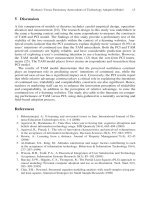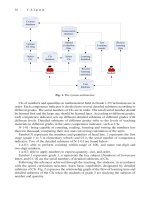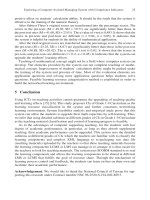Lecture Notes in Computer Science- P18 pot
Bạn đang xem bản rút gọn của tài liệu. Xem và tải ngay bản đầy đủ của tài liệu tại đây (217.74 KB, 5 trang )
ERDRM: A Digital Rights Management System Model for Educational Resources 75
4 The ERDRM System Model
Based on the previous sections, this section brings forth the ERDRM, a digital rights
management system model for educational resources.
4.1 Functional Components of the Model
Educational resources is based on a collection of files, including text, images, video
and other multimedia formats, but most of the formats cited above can be expressed
by HTML files, and HTML, GIF and JPG are common formats used in learning ob-
jects. Our system applies C/S infrastructure. There are server-side and client-side in
this model. The server provides three services: content packaging, licensing manage-
ment, content distributing. The core of Client is the trusted Add-on, which is in charge
of the requesting and executing of rights. Fig. 2 describes the functional components
in detail.
Trusted Add-on
License
Manager
The third party
License Manager
Access
Control
Packager
Licenses
management DB
User/role Info
DB
Learning
Objects
Repository
Content
Repository
Request/Licensing portal
Web Explorer
Content
Packaging
License Management
Resource Distribution
Server
Client
Fig. 2. The model’s functional components
Content Packaging. This module includes learning objects repository and packager.
Granularity is a key issue must be considered in the protection of resources. This model
encrypts and protects the content in denomination of learning object. The educational
resources to protect are stored in the learning objects repository. The packager encrypts
76 S. Wang
and Q. Liu
and packages the educational resources, and sends to users along with the metadata. It
also creates the rights, keys and other information which will be delivered to license
management module.
License Management. This module includes license manager, license management
DB, and the 3rd party license manager. It is mainly used to receive the request comes
from client, create and distribute license. License is a computer file consists of
permissions, keys and information about the author and distributor. Enlightened by
Osvaldo’s work [11], we use the third party license manager because of the reusable
features of educational resources. If the learning object is aggregated with another
object and that one was protected, the third party license manager works.
Resources Distribution. This module includes user/role information DB, content
repository, and access control, as well as a request/licensing portal. It handles the user
authentication, access control policy, education resource distribution and financial
business.
Client. This is a web explorer which contains a trusted Add-on. It helps users to
access and use the educational resources. The trusted Add-on collects users’ identities
and other information, controls the usage of the content. If no license is found, it will
make a license request to license manager.
4.2 Expression, Control and Implementation of Rights
Expression, control and executing of the rights information flow are very important in
DRM. As mentioned in section 1, both XrML and ODRL are XML-based and they
have been accepted by several standards organization. XrML is perfect but complex,
its parser is bulky and takes long time to download and run. XrML is protected by
patents. All these make it is far from a suitable REL for educational resources DRM
systems. On the other hand, ODRL has been a standard of OMA’s mobile DRM
rights expression language. COLIS, OPENIPMP and many other projects have ap-
plied ODRL as an REL. In our model, we still apply ODRL as reference REL.
4.3 DRM System on e-Learning Platform
Digital rights management of educational resources is part of the e-Learning platform, so
it has to integrate seamlessly with the other systems, such as learning management sys-
tem, learning content management system and resources management system (Fig. 3).
All entities in DRM-enabled e-Learning platform have to support the expression,
management and control of the learning object’s rights information. Learning object’s
rights information flow exists in the whole lifecycle. A simple example, learning con-
tent management system gain educational resources with rights attributes from re-
sources management system, and delivered them to learning object exchange system in
security, the DRM system protects the learning objects to be distributed and add rele-
vant authentication and rights information on them, then learning management system
manages the license and permissions. The user accesses and uses protected learning
objects while he or she participates in the activities of learning management system as
authorized. The user can reuse the learning object to create a totally new learning object.
ERDRM: A Digital Rights Management System Model for Educational Resources 77
Modules in a whole e-Learning platform have all kinds of interactions, which isn’t
limited to the situations mentioned above. In DRM-enabled e-Learning platform,
DRM system works on the Parties directory, learning object exchange system and
learning management system. In a broad sense, all entities have participated in the
implementation of digital rights management.
Learning
Management
Learning Content
Management
Resources
Management
Learning Object
Exchange
Parties
Directory
Reuse
Rights Tracking
Permissions
Management
Secure
Delivery
Rights
Attribution
Rights
Validation
Content Source
Content Use
DRM direct acting areas
DRM
System
Fig. 3. DRM-enabled e-Learning platform
5 Conclusion
Many e-Learning organizations and high schools have attempted to apply DRM tech-
nology in web-based education, but most of them focus on rights expression language
and the standards. There is no real mature solution for the realization of digital rights
management. By analyzing the education’s particular demands on digital rights man-
agement, we proposed a digital rights management system model for educational re-
sources. We studied the expression, control and execution of rights and the relationship
between DRM system and other systems on e-Learning platform in section 3. Our next
work is developing the product system based on the model. Many of these open issues
and problems are intertwined and will require an integrated approach to be satisfactorily
resolved, and this is the work we should make great efforts in the future.
Acknowledgments. This paper is supported by NSFC of China (NO.60673010),
partly supported by National Great Project of Scientific and Technical Supporting
Programs Funded by Ministry of Science & Technology of China During the 11th
Five-year Plan (NO. 2006BAH02A24), and supported by the Natural Science Foun-
dation of Hubei Province (NO. 2006ABC011).
78 S. Wang
and Q. Liu
References
1. Yu, Y Y., Tang, Z.: A Survey of the Research on Digital Rights Management. Chinese
Journal of Computers 28, 1957–1968 (2005)
2. Erickson, J.S.: OpenDRM: A Standards Framework for Digital Rights Expression, Mes-
saging and Enforcement (2002),
3. Erickson, J.S., et al.: Principles for Standardization and Interoperability in Web-based
Digital Rights Management: A position Paper for the W3C Workshop on Digital
Rights Management (2001), />erickson.html
4. Iannella, R.: Digital Rights Management (DRM) Architectures, b.
org/dlib/june01/iannella/06iannella.html
5. Friesen, N., Mourad, M., Robson, R.: Towards a Digital Rights Expression Language
Standard for Learning Technology, />standardDraft.doc
6. Iannella, R.: Digital Rights Management (DRM) in the Higher Education Sector. A report
in COLIS project (2002)
7. Pruneda, A.: Using windows media encoder to protect content,
articles/ProtectContent.aspx
8. Fan, K F., Mo, W., Cao, S.: Advances in Digital Rights Management Technology and
Application. Acta Electronic Sinica 35, 1139–1147 (2007)
9. Bertino, E., Khan, L.R., Sandhu, R., Thuraisingham, B.: Secure Knowledge Management:
Confidentiality, Trust, and Privacy. IEEE Transactions on Systems, Man and Cybernetics,
Part A: Systems and Humans 36, 429–438 (2006)
10. Park, J., Sandhu, R., Schifalacqua, J.: Security Architecture for Controlled Digital infor-
mation Dissemination. In: The Proceedings of the 16th Annual Computer Security Appli-
cations Conference, pp. 224–233. IEEE Computer Society Press, Washington (2000)
11. Santos, O.A., Ramos, F.M.S.: Proposal of a framework for Internet based licensing of
learning objects. Computers & Education 42, 227–242 (2004)
12. Iannella, R.: Open Digital Rights Language (ODRL), Version: 1.1 (2002),
13. The ODRL Initiative,
14. eXtensible rights Markup Language,
15. Open Mobile Alliance,
F. Li et al. (Eds.): ICWL 2008, LNCS 5145, pp. 79–86, 2008.
© Springer-Verlag Berlin Heidelberg 2008
Course Material Research Based on Perti Net
Kun Xiao
1
, Shihong Chen
1,2
, and Xi Chen
1
1
School of Computer, Wuhan University, Wuhan Hubei 430072, China
2
National MultiMedia Software Engineering Technology Research Center,
Wuhan University. Wuhan 430072, China
,,
Abstract. Many designers pay much more attention to establish an e-learning
system but ignore to judge what material is proper for courseware merger. This
paper tries to realize it via the Petri net. The relationship between material and
knowledge point (KP) is closely. So, in order to use the Petri net, it presents the
relationships among KP as the net firstly. Based on the relationships among KP,
It analyzes the relationships among material in detail and brings forth the mate-
rial sets (MS) net. And then, it gives the formalization description of the mate-
rial Petri net (MPN) based on the Petri net (PN) and provides the method of the
transformation from the MS net graph to MPN. When material is merged into
the courseware, some speciality of material can be checked by the MPN. The
experiments shows that the MPN can validate the reasonableness of the material
merger effectively.
Keywords: Petri net, material, courseware.
1 Introduction
The syllabus consistes of some knowledge point (KP), and KP may be reflected in the
different types of material. The method, which puts material and KP together, aids
teacher to organize the individual courseware automatically. Some researchers concern
the researchs of the KP[1, 2, 3], others concern the construct of e-learning[4, 5, 6]. They
have the good idea of utilizing e-learning[7, 8]. However, many intelligent tutor systems
organize the material into a suitable special courseware ineffectively. Although the KP
is in closely connection with the material, the KP and the material have a lot of different
still. The KP in the syllabus is always reflected in some material, and the material al-
ways reflects some KP. When the material is discussed, the relationships between the
material and the KP must be concerned together. If we ignore this point, we would have
difficulty to validate some cases.
• When the courseware is designed, any KP reflected in the material in the course-
ware does not excess the scope of the syllabus.
• If the material is learned in the courseware, it must reflect in one or more KP in the
syllabus.
• the material taught at the earlier stage does not use the KP reflected in material
taught at the latter stage.
